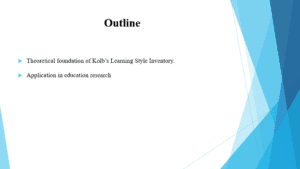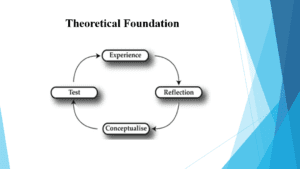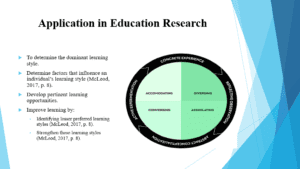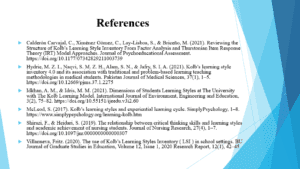Kolb’s Learning Style Inventory

Hello and welcome to today’s presentation on Kolb’s Learning Style Inventory. This presentation is specially tailored to evaluate the theoretical foundation of the learning style and discuss its application.

We will begin by discussing the theoretical framework of Kolb’s Learning Style Inventory. After that, we will discuss the applicability of Kolb’s Learning Style Inventory in educational research. Notably, we will focus on applying the theory in nursing research.

Kolb’s Learning Style Inventory (KLSI) measures a person’s preferred method of understanding and integrating knowledge throughout learning. An individual’s preferred learning style can be explained using Kolb’s Learning Style Inventory to indicate their learning preferences (Calderón Carvajal et al., 2021, p. 1-2). This plays a crucial role in making informed decisions regarding creating and delivering a curriculum. This comparatively reliable indicator of preferred learning style helps individuals or groups to develop self-awareness (Hydrie et al., 2021, pp. 1-2).

Effective learning occurs when a person moves through a cycle of interrelated phases. The first step is having a concrete experience. The second step is observing and reflecting on that experience (McLeod, 2017, p. 3). The third step is forming abstract concepts and conclusions. The fourth step entails using abstract concepts to test a hypothesis in new situations (McLeod, 2017, p. 3).

David Kolb developed his learning style inventory in 1984. This experiential learning theory consists of a cycle of learning and discrete learning styles. The learning style inventory focuses on the internal cognitive processes of the learner. The learning cycle consists of four modes: concrete experience, reflective observation, abstract conceptualization, and active experimentation. Substantial experience emphasizes engaging in events and personally addressing urgent human concerns. It prioritizes feeling over thinking, focusing on the intricacy and uniqueness of the present over theories and generalizations (Idkhan & Idris, 2021, pp. 2-3).
Additionally, it embraces an intuitive approach to problem-solving over a systematic, scientific one. Concrete experience provides a novel circumstance or event or a new interpretation of an old encounter in light of new ideas. Secondly, reflective observation emphasizes attentively observing and describing concepts and circumstances to understand their significance. Reflection and comprehension are prioritized over practical application (Idkhan & Idris, 2021, pp. 2-3). It is also more concerned with facts or how things operate than with what will work. Reflective observation enables the learner to consider new experiences in the context of their prior learning.

Third, abstract conceptualization emphasizes using concepts, ideas, and logic. It places more emphasis on thinking than feeling, developing broad ideas rather than intuitively grasping particular niche concepts, and a scientific rather than an aesthetic approach to solving issues (Idkhan & Idris, 2021, pp. 2-3). Fourth, active experimentation emphasizes actively influencing people and altering circumstances. It places a focus on real-world applications as opposed to reflective understanding. Furthermore, it embraces a pragmatic concern with what works rather than what is unquestionably true (Idkhan & Idris, 2021, pp. 2-3).

The KLSI is helpful in education research. Teachers use the learning phases and cycle to determine the dominant learning style and the learning opportunities generally available to students (McLeod, 2017, p. 8). After that, they develop pertinent learning opportunities for the students. Teachers must ensure that activities are planned and executed in a way that gives each learner the chance to participate in the best way that suits them. Additionally, by identifying their less favoured learning modes and enhancing them through the experiential learning cycle, students can be assisted in learning more efficiently (McLeod, 2017, p. 8).

Divergers can view situations from various angles. Divergent people are sensitive. Instead of acting, they prefer to observe, gather information, and develop creative solutions to issues (McLeod, 2017, pp. 5-6). They excel at taking a variety of perspectives on specific issues. Converging learners can solve problems and apply what they have learned to address real-world situations (McLeod, 2017, p. 7). They prioritize technical duties over interpersonal and social responsibilities. Less attention is paid to people, and more interest is shown in ideas and abstract concepts by those who learn by assimilation. Assimilators are more drawn to logically solid ideas than methods with a strong focus on application (McLeod, 2017, p. 6). Accommodators rely on the analyses of others and favour a hands-on, experienced approach. They are drawn to taking on new tasks and activities and following through on plans.

The KLSI is used to evaluate learning styles among nursing students. According to the theory, the dominant learning style affects an individual’s career choice. Findings among nursing students indicate that divergent, accommodative, and assimilative are the dominant learning styles among nursing students (Shirazi & Heidari, 2019, p. 3).
A small proportion of the students demonstrated dominance in the convergent learning style (Shirazi & Heidari, 2019, p. 3). Some factors limit the use of KLSI in nursing research. They include failure to explain the psychodynamic, social, and organizational aspects of learning (Villanueva, 2020, p. 1).

Calderón Carvajal, C., Ximénez Gómez, C., Lay-Lisboa, S., & Briceño, M. (2021). Reviewing the Structure of Kolb’s Learning Style Inventory From Factor Analysis and Thurstonian Item Response Theory (IRT) Model Approaches. Journal of Psychoeducational Assessment. https://doi.org/10.1177/07342829211003739
Hydrie, M. Z. I., Naqvi, S. M. Z. H., Alam, S. N., & Jafry, S. I. A. (2021). Kolb’s learning style inventory 4.0 and its association with traditional and problem-based learning teaching methodologies in medical students. Pakistan Journal of Medical Sciences, 37(1), 1–5. https://doi.org/10.12669/pjms.37.1.2275
Idkhan, A. M., & Idris, M. M. (2021). Dimensions of Students Learning Styles at The University with The Kolb Learning Model. International Journal of Environment, Engineering and Education, 3(2), 75–82. https://doi.org/10.55151/ijeedu.v3i2.60
McLeod, S. (2017). Kolb’s learning styles and experiential learning cycle. SimplyPsychology, 1–8. https://www.simplypsychology.org/learning-kolb.htm
uShirazi, F., & Heidari, S. (2019). The relationship between critical thinking skills and learning styles and academic achievement of nursing students. Journal of Nursing Research, 27(4), 1–7. https://doi.org/10.1097/jnr.0000000000000307
Villanueva, Fritz. (2020). Using Kolb’s Learning Styles Inventory ( LSI ) in school settings. BU Journal of Graduate Studies in Education, Volume 12, Issue 1, 2020 Research Report, 12(1), 42–45
ORDER A PLAGIARISM-FREE PAPER HERE
We’ll write everything from scratch
Question 
Select a Learning Style instrument from the list provided. Post in the Discussion area for faculty approval.
Please make a copy of the instrument or provide a web link to the instrument and send it to all classmates to complete. Classmates will post their completed results in the “Learning Styles Assessment Results” discussion forum.

Kolb’s Learning Style Inventory
Analyze the data received. This will include results for the entire class. You will not share individual results but look at the aggregate data.
Develop a PowerPoint presentation including the following:
-
- Discuss the theoretical foundation of the selected instrument. You may only be able to find the history of its development.
- Discuss how this instrument has been used in educational research, particularly Nursing research.
- Give an example of one research study in nursing that used this learning assessment instrument and discuss the study’s conclusions and recommendations.
- Utilize the learning assessment instrument to assess the learning style of class members. Don’t share any individual results. Discuss them as an aggregate.
- Discuss how the assessment results impact teaching styles.
This is a GROUP project. Each member must participate to receive a grade.